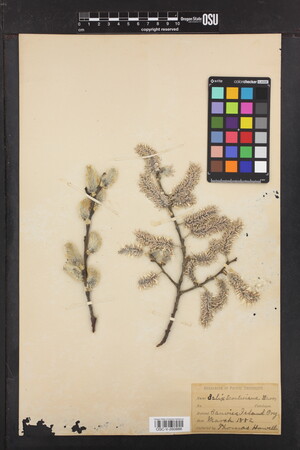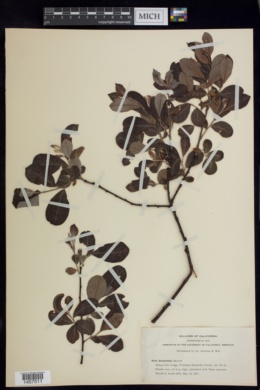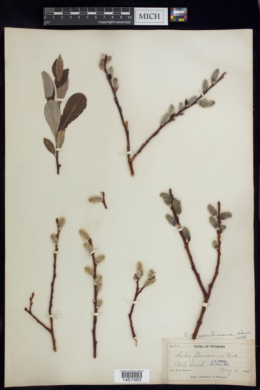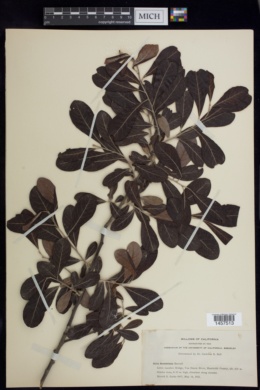

- Home
- Specimen Search
- Images
- Flora Projects
- Agency Floras
- Dynamic Floras
-
Additional Websites
- New Mexico Flores
- Plant Atlas Project of Arizona (PAPAZ)
- Southwest Colorado Wildflowers
- Vascular Plants of the Gila Wilderness
- Consortium of Midwest Herbaria
- Consortium of Southern Rocky Mountain Herbaria
- Intermountain Region Herbaria Network (IRHN)
- Mid-Atlantic Herbaria
- North American Network of Small Herbaria (NANSH)
- Northern Great Plains Herbaria
- Red de Herbarios del Noroeste de México (northern Mexico)
- SERNEC - Southeastern USA
- Texas Oklahoma Regional Consortium of Herbaria (TORCH)
- Resources
|
|
|
|
Family: Salicaceae
Scouler's Willow, more...Scouler willow
[Salix brachystachys Benth., moreSalix brachystachys var. scouleriana (Barratt ex Hook.) Anderss., Salix capreoides Anderss., Salix flavescens Nutt., Salix flavescens var. capreoides (Anderss.) Bebb, Salix flavescens var. scouleriana (Barratt ex Hook.) Bebb, Salix nuttallii Sarg., Salix nuttallii var. brachystachys Sarg., Salix nuttallii var. capreoides (Anderss.) Sarg., Salix scoulerana Barratt ex Hook., Salix scouleriana var. brachystachys (Benth.) M.E. Jones, Salix scouleriana var. coetanea Ball, Salix scouleriana var. crassijulis (Anderss.) Schneid., Salix scouleriana var. flavescens (Nutt.) J.K. Henry, Salix scouleriana var. poikila Schneid., Salix scouleriana var. scouleriana , Salix scouleriana var. thompsonii Ball, Salix stagnalis Nutt., Salix wendtii] |
Shrubs or trees, 1-10(-20) m. Stems: branches gray-brown, yellow-brown, or red-brown, not glaucous, glabrous or tomentose; branchlets yellow-green or yellow-brown, sparsely to densely villous, tomentose, or velvety. Leaves: stipules absent, rudimentary, or foliaceous on early ones, foliaceous on late ones, (1-16 mm), apex acute or acuminate; petiole convex to flat adaxially, 2-13 mm, velvety or villous adaxially; largest medial blade usually oblanceolate, sometimes narrowly elliptic, elliptic or obovate, 29-100 × 9-37 mm, 1.7-3.9 times as long as wide, base cuneate or convex, margins strongly to slightly revolute or flat, entire, remotely serrate, crenate, or sinuate, (glands submarginal or epilaminal), apex acuminate, convex, or rounded, abaxial surface glaucous, sparsely to densely short- to long-silky or woolly, hairs (white, sometimes also ferruginous), wavy or straight, adaxial slightly glossy, pilose or moderately densely short-silky, midrib velutinous or villous, (hairs white, sometimes also ferruginous); proximal blade margins entire, serrulate, or crenulate; juvenile blade reddish or yellowish green, sparsely to densely villous, short- or long-silky abaxially, hairs white, sometimes also ferruginous. Catkins flowering before leaves emerge; staminate stout or subglobose, 18-40.5 × 8-22 mm, flowering branchlet 0-4 mm; pistillate very densely flowered, slender or stout, 18-60(-90 in fruit) × 10-22 mm, flowering branchlet 0-8 mm; floral bract brown, black, or bicolor, 1.5-4.5 mm, apex rounded or acute, abaxially hairy, hairs straight. Staminate flowers: adaxial nectary oblong or square, 0.4-0.9 mm; filaments distinct, glabrous or hairy on proximal 1/2; anthers purple turning yellow, ellipsoid to shortly cylindrical, 0.7-1.2 mm. Pistillate flowers: adaxial nectary oblong or square, 0.2-0.8 mm, shorter than stipe; stipe 0.8-2.3 mm; ovary pyriform or obclavate, densely long-silky, beak slightly bulged below styles; ovules 10-18 per ovary; styles 0.2-0.6 mm; stigmas slenderly cylindrical, 0.4-0.82-1.04 mm. Capsules 4.5-11 mm. 2n = 76. Flowering late Feb-mid Jun. Dry conifer forests, mature woods on edges of streams and lakes, treed bogs, meadows, subalpine slopes, springs, pine barrens, openings in old burns, arroyos and disturbed sites, sandy, silty-clay, or gravelly, igneous substrates; 0-3500 m; Alta., B.C., Man., N.W.T., Sask., Yukon; Alaska, Ariz., Calif., Colo., Idaho, Mont., Nev., N.Mex., Oreg., S.Dak., Utah, Wash., Wyo.; Mexico (Chihuahua, Sonora). Western Salix scouleriana and eastern S. humilis are closely related and are sometimes difficult to separate. Although there is an apparent range disjunction between them in western Manitoba, it may be a collecting gap. In general, S. scouleriana differs from S. humilis in being a taller shrub, sometimes even tree-like, with broader leaves and longer catkins, floral bracts, stigmas, and styles, but these quantitative characteristics all overlap. The apparent difference in anther length (S. scouleriana 0.7-1.2 mm; S. humilis 0.4-0.6 mm) may be correlated with a difference in chromosome number. Salix scouleriana is tetraploid (Y. Suda and G. W. Argus 1968); S. humilis has been reported to be both diploid (Suda and Argus; L. Zsuffa and Y. Raj, unpubl.) and tetraploid (R. D. Dorn 1976). The latter count was from the same population as the one by Suda and Argus. Further chromosome counts are indicated. See 77. Salix hookeriana for comparative descriptions. Hybrids: Salix scouleriana forms natural hybrids with S. hookeriana, S. planifolia, and S. pulchra.
Plant: tree or shrub; to 10(-20) m tall; branches gray-, yellow-, or red-brown, tomentose becoming glabrous; branchlets yellow-green to yellow-brown, velvety, villous, or tomentose Leaves: petioles velvety or villous, 2-13 mm long; young leaves villous to silky; mature blade narrowly elliptic to oblanceolate or obovate, 29-80 mm long, 9-36 mm wide, 1.7-3.9 times as long as wide, the lower surface glaucous, short silky or tomentose with white and rust-colored hairs or white-woolly, the upper surface shiny, pilose or silky, becoming glabrous; base cuneate to rounded, the margins strongly revolute, entire, gland-dotted to irregularly serrate, with 1-4 teeth or glands per cm, the apex acute to rounded INFLORESCENCE: cylindrical to subspherical catkins; precocious; floral bracts dark or light brown or bicolored, 1.5-4.5 mm long, with straight hairs, the apices rounded or acute Flowers: STAMINATE FLOWERS in densely flowered catkins 15-45 mm long, sessile; filaments glabrous; nectary broad, 0.4-0.8 mm long. PISTILLATE FLOWERS in densely flowered catkins 25-65 mm long; flowering branchlets 0-6 mm long; ovaries silky; stigmas 0.4-1.04 mm long; styles 0.2-0.6 mm long; stipes 0.8-2.3 mm long; nectary broad, 0.2-0.7 mm long, shorter than stipe Fruit: lanceolate to ovate Misc: Montane; dry to moist slopes in high elevation forests, meadows, springs; 2100-3400 m (6400-10600 ft); May-June, second flowering in Jul REFERENCES: Argus, George W. 1995. SalicaceaePart 2. Salix. J. Ariz. - Nev. Acad. Sci. 29(1): 39 FNA 2010, Argus 1995 Common Name: Scouler's willow Duration: Perennial Nativity: Native Lifeform: Tree Wetland Status: FAC General: Shrub or trees to 10 m tall, with brown bark with gray, yellow, or reddish tinge on mature branches, young branches and stems yellowish green or brown, pubescent to tomentose on all branches, sometimes villous on younger branches. Leaves: Mature leaves with foliaceous stipules, elliptic to obovate to 10 cm long with acuminate tips, 1.5-4 times as long as wide, pubescent to villous beneath, glossy green on the leaf surface, younger leaves reddish or yellowish green, margins minutely toothed to entire, sometimes revolute. Flowers: Catkins staminate and pistillate, staminate flowers with purple anthers turning to yellow, to 1 mm. Flowering before leaves emerge, catkins are slender to stout for both staminate and pistillate, pistillate catkins very densely flowered, staminate catkins sometimes sub-globose. Floral bract black, brown, or bi-colored. Fruits: Capsules 4-11 mm long. Ecology: Found on igneous substrates in sandy, silty, or gravelly areas in disturbed sites, drainages, openings in burned areas, forests, bogs, and sub-alpine meadows, from sea level to 11,500 ft (3505 m); flowers February-June. Notes: Widespread throughout the United States, this species forms hybrids with Salix hookeriana, S. planifolia, and S. pulchra. This species is distinguished by its velvety petioles and branchlets, oblanceolate medial blades (the largest ones), and densely long-silky ovaries. Ethnobotany: Poultice of bark used for cuts and sanitary napkins. Decoction of branches taken after childbirth. Decoction of roots taken to counteract diarrhea. Wood used to smoke salmon, make baskets, fish weirs, and water jugs. Bark used to make cord for rope, bags, and sandals. Etymology: Salix is the Latin name for willow, meaning -to leap or spring-, while scouleriana is named after Dr. John Scouler (1804-1871), a plant collector who worked mainly in the American Northwest. Synonyms: Numerous, see Tropicos Editor: LCrumbacher, 2011 |
|
|
|

Development supported by National Science Foundation Grants
(DBI 9983132,
BRC 0237418,
DBI 0743827,
DBI 0847966)
Powered by Symbiota
Powered by Symbiota




































































































